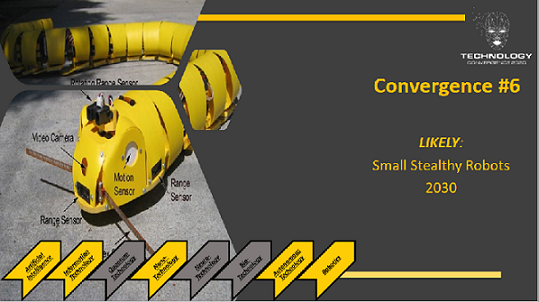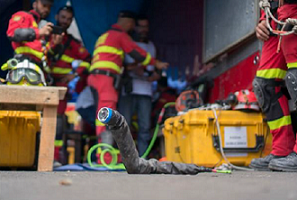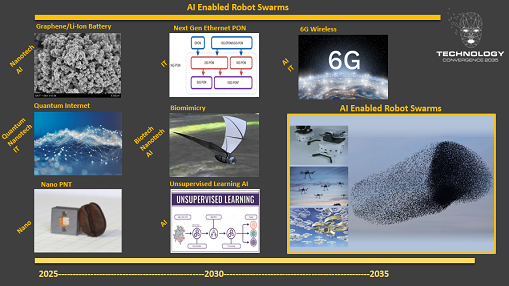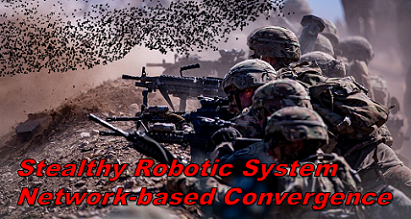[Editor’s Note: The Mad Scientist Laboratory is pleased to feature today’s post by Lt Col Nicholas Delcour (USAF), Lt Col Louis Duncan (USAF), Mr. Stephen Frahm (DOS), CDR Patrick Lancaster (USN), and Lt Col Lance Vann (USAF), under the direction of Prof. Kristan Wheaton, U.S. Army War College. Extracted from these Mad Scientist Fellows’ Estimation of Technology Convergence Final Report,  the post addresses one of the six technological convergences identified as “relevant to the United States Army over the next 15 years.” While we have previously synopsized this report, today’s post drills down and explores the convergences that may yield “small and stealthy robotic systems that operate below detection thresholds by 2030.” Complementing our on-going series of Mad Scientist Robotics & Autonomy Virtual Events, this post explores how “expensive and highly capable military platforms will likely be replaced by many, cheap, and good enough systems that create ‘battlefield mass.’” — Enjoy!]
the post addresses one of the six technological convergences identified as “relevant to the United States Army over the next 15 years.” While we have previously synopsized this report, today’s post drills down and explores the convergences that may yield “small and stealthy robotic systems that operate below detection thresholds by 2030.” Complementing our on-going series of Mad Scientist Robotics & Autonomy Virtual Events, this post explores how “expensive and highly capable military platforms will likely be replaced by many, cheap, and good enough systems that create ‘battlefield mass.’” — Enjoy!]
Innovations in longer-life, rapid charging batteries, navigation in a GPS-denied environment, bio-inspired robot designs, nanotech soft materials and multi-robot cooperative systems (aka “Swarms“) converging with artificial intelligence, 5G (or higher) communication and advanced fabrication like 3D printing are likely to encourage the development of small and/or stealthy robotic systems that operate below detection thresholds by 2030.

As industrial-scale robotics manufacturing evolves, future warfare is likely to see a rebalance away from militaries built around the few, expensive, and highly capable platforms to many, cheap, and “good enough” systems that create “battlefield mass.” However, commercial and international action to limit the combat role of military robots will likely result in an international convention against deploying lethal autonomous weapon systems (LAWS).
-
-
- Long-life, quick charging battery research is advancing in a variety of ways (i.e., enhanced li-ion and graphene) resulting from the high demand in commercial markets. Tesla filed a patent in 2019 for a new breed of lithium-ion batteries that could last for a million miles in their cars. Innolith, a Swiss startup, says its new high-density lithium-ion batteries are “four times the current state-of-the-art for lithium-ion… Roughly three times what is generally accepted as being the next improvement in lithium. And it’s two times the energy density target [that] organizations like the US Department of Energy have set.” Volkswagen pledged $48 billion to the leading battery manufacturers in Asia to max out current battery tech. A recent Bloomberg New Energy Finance study estimated lithium-ion battery production capacity will nearly quadruple by 2021. The graphene battery market will reach $115M by 2022, with a 38.4 percent combined annual growth rate each year thereafter.
-
-
-
- The intrinsic properties of materials in soft robots created from the convergence of nano-and bio-technology allow for an “embodied

The Robotics Institute’s multi-jointed Snakebot robot, which was deployed to search for survivors following the Mexico City earthquake was named Ground Rescue Robot of the Year in 2018 by the Center for Robot-Assisted Search and Rescue (CRASAR) / Source: cmu.edu intelligence” that can potentially reduce the mechanical and algorithmic complexity in ways not possible with rigid-bodied robots. Soft robotics can be combined with tissue engineering and synthetic biology to create bio-hybrid systems with unique sensing, dynamic response, and mobility. Bioinspired soft robots can expedite the evolution of co-robots that can safely interact with humans.
- The intrinsic properties of materials in soft robots created from the convergence of nano-and bio-technology allow for an “embodied
-
-
-
- Thomas Schmickl of the Artificial Life Laboratory at the University of Graz in Austria says the possibility to create swarms that mimic the way simple animals (like the insect world) behave in ingenious ways as a group can provide some insight into how to simulate intelligence. The US military has come to much the same conclusion with respect to combat missions. Swarm robotics has become not just viable but a cornerstone of coming drones – unmanned aerial vehicles, in military parlance. Souma Chowdhury, assistant professor of mechanical and aerospace engineering at Buffalo, said: “It’s becoming known that there are a lot of different applications which could be done by not using a single $1 million robot, but rather a large swarm of simpler, cheaper robots…. These could be ground-based, air-based, or a combination of those two approaches.”
-
-
-
- Moral concern about the use of robots by the military within the tech industry, coupled with pragmatic diplomacy from major states eager to lock in their relative advantages while using collective power to lock out competitors, will likely result in an international agreement with provisions (albeit unenforceable) against combat robots.
-

Use Cases
-
-
- Militaries are developing doctrine that moves away from emphasizing platforms with greater capabilities (e.g., the F-35 fighter jet) to the concept of saturating an enemy with swarms of cheaper, more expendable robots.
-
-
-
- Ash Carter, Director of the Belfer Center for Science & International Affairs at Harvard Kennedy School and former defense secretary, talked about “swarming, autonomous vehicles” —the use of greater volumes

Russia is planning to use swarms of more than 100 drones. Each drone would pack an explosive charge, and the swarms would be unleashed on convoys and other targets. / Source: Popular Mechanics of aircraft or ships in a conflict. The emphasis in American military technology in recent decades has been on developing weapons platforms that are deployed in fewer numbers but boast much greater capabilities, such as the F-35 fighter jet. However, backed by low-cost production techniques such as 3D printing, a different model that seeks to saturate an enemy with swarms of cheaper, more expendable robots is viable.
- Ash Carter, Director of the Belfer Center for Science & International Affairs at Harvard Kennedy School and former defense secretary, talked about “swarming, autonomous vehicles” —the use of greater volumes
-
-
-
- Robert Work, former deputy secretary of defense, believes this will give the US an advantage over its more authoritarian rivals, who are likely to place more emphasis on completely automated solutions because they do not put so much trust in their people. “Tech-savvy people who have grown up in a democracy, in the iWorld, will kick the crap out of people who grow up in the iWorld in an authoritarian regime,” he said.
-
-
-
- Swarm robotics can be used to tackle dangerous tasks to reduce or eliminate the risk for humans. They are flexible and scalable which permits adding or removing robots as needed to give the right amount of resources according to the evolving requirements of the job. Swarm robotics are also useful when it’s necessary to accomplish tasks within very large or informal environments because of their ability to work autonomously without any infrastructure or centralized control system. Certain environments change rapidly over time—natural disasters like hurricanes or earthquakes. Buildings may collapse, altering the original layout of the environment and creating unforeseen hazards.
-
If you enjoyed this post, check out the following:
Estimation of Technological Convergence by 2035 and the associated final report, from which today’s blog post was excerpted, and the associated briefing slides.
Content on the status of current and future U.S., Russian, and Chinese Ground, Air, and Maritime Unmanned Systems from our ongoing series of Mad Scientist Robotics and Autonomy Virtual Events and the associated webinar videos (access via a non-DoD network).
How Big of a Deal are Drone Swarms? by proclaimed Mad Scientist Zak Kallenborn.
Jomini’s Revenge: Mass Strikes Back! by proclaimed Mad Scientist Zachery Tyson Brown.
“Own the Night” and the associated Modern War Institute podcast with proclaimed Mad Scientist Mr. Bob Work.
Table of Future Technologies: A 360 Degree View Based on Anticipated Availability and the associated Table of Future Technologies, created by Richard Buchter.
Ethics, Morals, and Legal Implications.
Disclaimer: All views expressed here are the authors’ and do not necessarily reflect those of the Department of Defense, Department of the Army, Army Futures Command (AFC), or Training and Doctrine Command (TRADOC).



